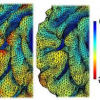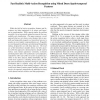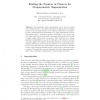534 search results - page 63 / 107 » Data Separation by Sparse Representations |
ISBI
2004
IEEE
14 years 11 months ago
2004
IEEE
Surface data such as the segmented cortical surface of the human brain plays an important role in medical imaging. To increase the signal-to-noise ratio for data residing on the b...
ICCV
2009
IEEE
13 years 8 months ago
2009
IEEE
Within the field of action recognition, features and descriptors are often engineered to be sparse and invariant to transformation. While sparsity makes the problem tractable, it ...
CAIP
2005
Springer
14 years 3 months ago
2005
Springer
Non-parametric data representation can be done by means of a potential function. This paper introduces a methodology for finding modes of the potential function. Two different me...
CVPR
2007
IEEE
15 years 5 days ago
2007
IEEE
The goal of this paper is to find sparse and representative spatial priors that can be applied to part-based object localization. Assuming a GMRF prior over part configurations, w...
DAWAK
2010
Springer
13 years 11 months ago
2010
Springer
Abstract. Pearson product-moment correlation coefficients are a wellpracticed quantification of linear dependence seen across many fields. When calculating a sample-based correlati...



